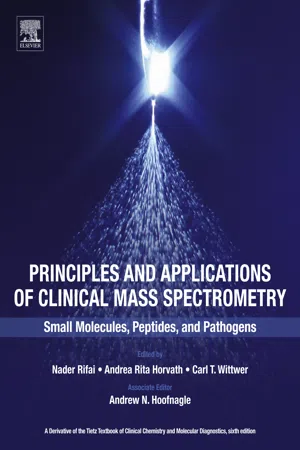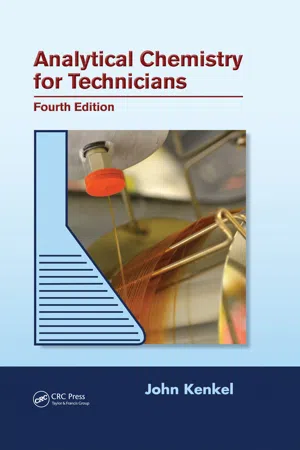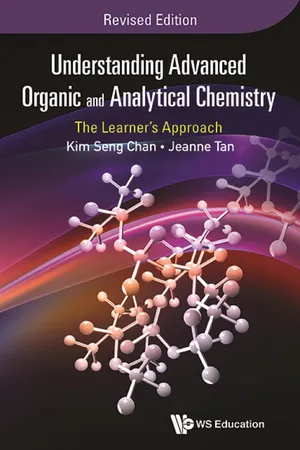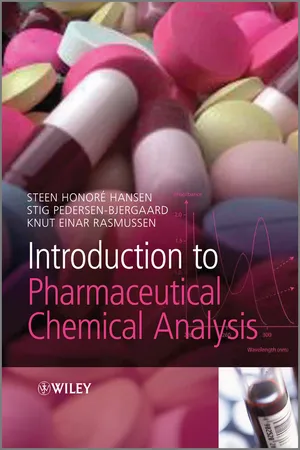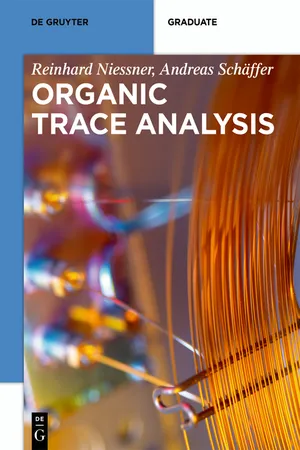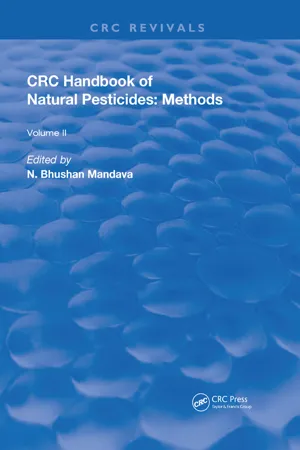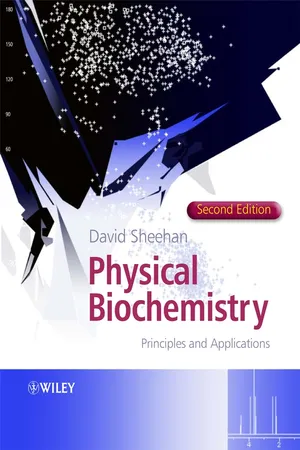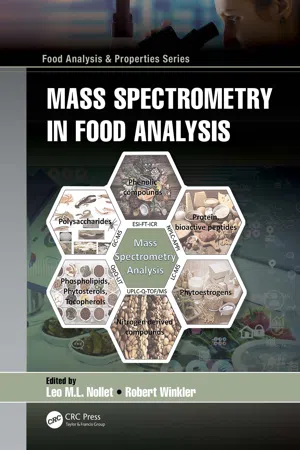Chemistry
Mass Spectrometry
Mass spectrometry is a technique used to analyze the composition of a sample by measuring the mass-to-charge ratio of its ions. It involves ionizing the sample, separating the ions based on their mass, and detecting them to generate a mass spectrum. This powerful tool is widely used in chemistry for identifying compounds, determining their structure, and quantifying their abundance.
Written by Perlego with AI-assistance
Related key terms
Related key terms
1 of 4
Related key terms
1 of 3
10 Key excerpts on "Mass Spectrometry"
- eBook - ePub
Principles and Applications of Clinical Mass Spectrometry
Small Molecules, Peptides, and Pathogens
- Nader Rifai, A. Rita Horvath, Carl T. Wittwer, Andy Hoofnagle(Authors)
- 2018(Publication Date)
- Elsevier(Publisher)
2Mass Spectrometry
Alan L. Rockwood, Mark M. Kushnir, and Nigel J. Clarke∗Abstract
BackgroundMass Spectrometry is a powerful analytical technique used to identify and quantify analytes using the mass-to-charge ratio (m/z) of ions generated from a sample. It is useful for the analysis of a wide range of clinically relevant analytes, including small molecules, proteins, and peptides. When Mass Spectrometry is coupled with either gas or liquid chromatographs, the resultant analyzers have expanded analytical capabilities with widespread clinical applications, including quantitation of analytes from myriad body tissues and fluids. In addition, because of its ability to identify and quantify proteins, Mass Spectrometry is widely used in the field of proteomics.ContentThis chapter describes the basic concepts and definitions of Mass Spectrometry. Techniques based on Mass Spectrometry require an ionization step wherein an ion is produced from neutral atoms or molecules. Electron impact and chemical ionization (CI) are often used in gas chromatography–Mass Spectrometry. In liquid chromatography–Mass Spectrometry, electrospray ionization (ESI) and atmospheric pressure CI are the most commonly used techniques. In microbiology, a desorption/ionization technique termed MALDI (matrix-assisted laser desorption ionization) is employed. Each of these ionization techniques is described in detail, and advantages of the techniques are highlighted. Once molecules are ionized, resultant ions are analyzed using either beam type analyzers (eg, quadrupole, or time-of-flight [TOF]) or trapping mass analyzers (eg, ion trap). Mass analyzers also can be combined to form tandem mass spectrometers, which allow further expending capabilities of the technique. Clinical applications of Mass Spectrometry are provided to illustrate the role of this technique in the analysis of clinically relevant analytes. - eBook - ePub
- John Kenkel(Author)
- 2013(Publication Date)
- CRC Press(Publisher)
13 Mass Spectrometry13.1 Basic Principles
Mass Spectrometry is an instrumental analytical technique that provides information about a molecule’s mass. It generates ions from analyte atoms or molecules, separates these ions from each other on the basis of their mass and charge, and then generates an electronic signal for each. The series of sharp peaks, one for each ion, is then displayed as a so-called mass spectrum , which is a plot of the signal vs. mass-to-charge ratio. The magnitude of each signal is proportional to the number of each ion found.Although the technique is named a “spectrometric” or “spectroscopic” technique, and the word “spectrum” is used to describe the data, it does not use light at all. The name likely results from the very early instruments in which photographic plates or phosphor screens were used to detect the ions. Also, the modern instruments use ion detectors that are similar in function to photomultiplier tubes used in spectroscopy, as we shall see in Section 13.4 . One could consider that the ions are separated from each other in a manner that is analogous to how a monochromator functions in separating wavelengths and displaying an absorption spectrum. Instead of scanning wavelengths and developing an absorption signal for each wavelength, many mass spectrometer designs scan electric field strength, separate ions based on mass-to-charge ratio, and then produce a signal for each in the mass detector. In any case, the technique is called Mass Spectrometry; instruments are called mass spectrometers; and the data generated are referred to as mass spectra.The mass spectrum consists of a series of sharp peaks resembling vertical lines, each due to an ion of a particular mass-to-charge ratio. The example given in Figure 13.1 is for a very simple molecule, methane, CH4 . The charged formulas indicated there next to each vertical line all result from the fragmentization of methane molecules. The CH3 + and CH4 + - eBook - ePub
Understanding Advanced Organic and Analytical Chemistry
The Learner's ApproachRevised Edition
- Kim Seng Chan, Jeanne Tan;;;(Authors)
- 2016(Publication Date)
- WS EDUCATION(Publisher)
CHAPTER 14
Mass Spectrometry
14.1 Introduction
Mass Spectrometry is an analytical technique that enables us to determine the chemical composition of a sample and elucidate the structures of compounds based on the mass-to-charge ratio of charged particles.The fundamental principle lies in the fact that charged particles of different mass and charge behave differently in an electric or magnetic field. If we have a beam of positively charged particles moving across an electric field, it will deviate from its original path and get deflected towards the negative plate. If the beam is comprised of negatively charged particles, it will deflect towards the positive plate. All this is in accordance with the concept of like charges repel and unlike charges attract.An atom is electrically neutral since it contains equal numbers of protons and electrons. A beam of atoms moving across an electric field will continue in its path and not be deflected at all. Molecules made up of atoms are also neutral species, so how can we use this technique to identify molecules? We can actually transform these neutral species into positively charged particles through the process known as ionization. Electrons are forcefully removed from atoms (even those which tend to form anions), which makes ionization an energetically demanding but possible process.If a sample containing different molecules is ionized into positively charged species, how do we identify them if they deflect towards the same negative plate? These like charges are differentiated by the amount of deviation from their trajectory, defined as the angle of deflection (θ):The positively charged species with the higher charge experiences greater attractive force exerted by the negative plate and deviates more from its trajectory. For two ions of the same unit charge but different masses travelling at the same speed, the heavier particle has a greater kinetic energy (K.E. = 1/2 mv2 - eBook - ePub
- Steen Honoré Hansen, Stig Pedersen-Bjergaard, Knut Rasmussen(Authors)
- 2011(Publication Date)
- Wiley(Publisher)
Chapter 16 Mass Spectrometry16.1 IntroductionThis chapter discusses the principles of identification and quantitative analysis based on Mass Spectrometry (MS). MS is an official technique in the European Pharmacopoeia (Ph.Eur.). MS is mainly used for the analysis of drug substances in biological samples. Various MS techniques will be reviewed, and the most widely used instrumentation will be discussed. Applications of MS are presented in Chapter 23 in connection with the bioanalysis of drug substances.Mass Spectrometry is performed using a relatively expensive and sophisticated instrument called a mass spectrometer (MS). The MS is normally coupled to either gas chromatography (GC-MS) or liquid chromatography (LC-MS). In the case of GC-MS, the analytes (drug substances and other organic compounds) are bombarded with electrons in a vacuum inside the mass spectrometer. Initially, this leads to some of the molecules being ionized either to positive ions (molecules lose an electron) or negative ions (molecules take up an electron). These ions are called molecular ions . The mass of an molecular ion is equivalent to the mass of the original molecule because the weight of an electron that is either lost or taken up is incredibly small. In some cases, molecular ions are unstable and very quickly split into smaller fragments as chemical bonds in the molecules are broken. This process is called fragmentation . Some of the fragments remain ionized (fragment ions ), while others lose their charge. Figure 16.1 shows an example of how ionization and fragmentation can take place. When chlorambucil (antineoplastic drug) is bombarded with electrons in the mass spectrometer, some of the molecules ionize to the positively charged molecular ions with mass 303. A large proportion of these are unstable and will fragment. Fragmentation of chlorambucil occurs due to several reactions, but only one of them is discussed at this stage. The dominating process is the cleavage of CH2 Cl from the molecular ion. The weight of CH2 - eBook - ePub
- Reinhard Nießner, Andreas Schäffer(Authors)
- 2017(Publication Date)
- De Gruyter(Publisher)
9Mass Spectrometry9.1Introduction
Mass Spectrometry (MS) is certainly the highest performer and best service provider among the detection techniques, combined with chromatography or other separation schemes. Briefly spoken, MS makes use of the determination of electrical mobility of charged species within an electromagnetic field, thus representing an orthogonal separation technique to chromatography (i.e., two essentially different methods used to separate the same analyte). Hyphenation of both generates extremely high resolutions in separating complex samples, required for example in crude oil analysis, protein characterization or nontargeted analysis within the fields of -omic techniques [1 ].Already 100 years ago, Dempster and Aston (1918/1919) were forerunners of the modern MS technology, after Thompson (1911) had detected the separation of gas ions within an electric field. Furthermore, tremendous technical advances were achieved during World War II, when huge sector-field MS instruments were built and run in parallel for preparative uranium isotope fractionation (“Manhattan project”). With the advent of various energy-selective and intensity-adapted ionization techniques (e.g., by laser, radiation from radioactive decay, inductively coupled plasma, collision-rated ionization or thermal surface interaction, etc.), the applications became numerous [2 ].Nowadays, MS is (beyond the still applied isotope fractionation) mainly used for separation and identification of larger organic molecules (up to >100 kDa), derived from environment, industry and life sciences. In contrast to the first very bulky and heavy versions (due to huge magnets and vacuum pumping), nowadays table-top instrumentation with high-resolution capabilities is available, and miniaturized instruments are already a permanent part of space missions for extraterrestrial research [3 - eBook - ePub
Handbook of Natural Pesticides: Methods
Volume II: Isolation and Identification
- N. Bhushan Mandava(Author)
- 2019(Publication Date)
- CRC Press(Publisher)
Mass SpectrometryJohn M. RuthINTRODUCTION
The mass spectrometer is an apparatus which takes molecules in the vapor phase or on the surface of a condensed phase, ionizes them, sorts the resulting mixture of gas-phase ions according to the magnitude of their mass-to-charge ratio m/q and produces a record of the ion intensity I as a function of m/q. The function I(m/q) is called the mass spectrum. In most types of mass spectrometer, the sorting is accomplished by means of the electrical, magnetic, or translational properties of ions in a beam traveling out of the ion source toward a suitable detector. In the ion cyclotron resonance mass spectrometer, the frequencies associated with ionic motion, which are dependent upon the masses of the ions, are sorted without accelerating the ions out of the source. In the ultimate version of that instrument, the Fourier-transform mass spectrometer (FT-MS) an ion excitation decay transient is converted into an ion cyclotron resonance frequency spectrum, from which a mass spectrum is calculated, through a technology analogous to that used in IR and NMR spectroscopy.The intensity I may be expressed in terms of the number of ions of a given m/q value detected per unit time, or in terms of some unit of measurement of an electrical signal or of the height of a peak on a recorder chart that is proportional to the number of ions per unit time. That is, the intensity I has the dimensions of a current. At this point, it is evident that if the value of I is sufficiently small, the reproducible measurement of it will require attention to the statistical nature of it, with averaging over an adequate interval of time by an integrating detection mechanism. The reason why the independent variable in the function I(m/q) is the mass-to-charge ratio m/q and not simply m will be seen later when the actions of some mass analyzers are briefly examined. In the meantime, the reader is free to make a decision as to whether a given ion is singly charged, doubly charged, or (what will be extremely rare in organic chemical work) has some larger number of charges. Indeed, that decision will always have to be made, and it then becomes perfectly correct to speak of the mass of the ion, and not the mass-to-charge ratio. For positive ions, let e be the charge on a proton and z be the number of such units of charge on the ion. The number z is a small integer, most often 1, occasionally 2, and very rarely 3 or higher. Then the quantity q of charge on the ion is expressed by - Jeroen Kool, Wilfried M. A. Niessen, Jeroen Kool, Wilfried M. A. Niessen(Authors)
- 2015(Publication Date)
- Wiley-VCH(Publisher)
1 Introduction to Mass Spectrometry, a TutorialWilfried M.A. Niessen and David Falck1.1 Introduction
In the past 30 years, Mass Spectrometry (MS) has undergone a spectacular development, in terms of both its technological innovation and its extent of application. On-line liquid chromatography–Mass Spectrometry (LC–MS) has become a routine analytical tool, important in many application areas. The introduction of electrospray ionization (ESI) and matrix-assisted laser desorption/ionization (MALDI) has enabled the MS analysis of highly polar and large molecules, including biomacromolecules. MS is based on the generation of gas-phase analyte ions, the separation of these ions according to their mass-to-charge ratio (m/z), and the detection of these ions. A wide variety of ionization techniques are available to generate analyte ions (Section 1.3). Mass analysis can be performed by six types of mass analyzers (Section 1.4), although quite frequently tandem mass spectrometers, featuring the combination of two mass analyzers, are used (Section 1.5). The data acquired by MS allow quantitative analysis of target analytes, determination of the molecular mass/weight, and/or structure elucidation or sequence determination of (unknown) analytes (Section 1.6).This chapter provides a general introduction to MS, mainly from a functional point of view. Next to basic understanding of operating principles of ionization techniques and mass analyzers, the focus is on data interpretation and analytical strategies required in the study of biomolecular interactions using MS.1.2 Figures of Merit
1.2.1 Introduction
An MS experiment typically consists of five steps: (i) sample introduction, (ii) analyte ionization, (iii) mass analysis, (iv) ion detection, and (v) data processing and interpretation of the results. Sample introduction may involve individual samples or may follow (on-line) chromatographic separation. Mass analysis and ion detection require a high vacuum (pressure ≤ 10−5- eBook - ePub
Physical Biochemistry
Principles and Applications
- David Sheehan(Author)
- 2013(Publication Date)
- Wiley(Publisher)
Chapter 4
Mass Spectrometry
Objectives After completing this chapter you should be familiar with:- The physical basis of Mass Spectrometry (MS ).
- The range of MS methods available .
- How MS techniques can be interfaced with other high-resolution techniques .
- How MS techniques can be applied to the study of biomolecules such as proteins, peptides and DNA .
A wide range of molecular mass is found in living cells varying from very tiny ionic species such as Na+ to molecules made up of many thousands of atoms such as proteins and DNA. These molecules possess a variety of mass/charge (m /z ) ratios, depending on their mass, m , and their charge (positive or negative), z . If we pass such a mixture through a powerful magnetic field, its components will be deflected differently based on this ratio, giving a means of making very accurate mass measurements. A variety of ionization methods are available to impart charge and momentum to sample molecules in the gas phase, which may then pass through a magnetic field and be differentially deflected. These methods vary in the energy they give to the sample molecules and in the degree to which they may cause fragmentation of their chemical structure. Depending on the ionization method chosen, it is therefore possible to determine a highly accurate mass for an intact chemical species or, alternatively, to fragment it into smaller pieces. The pattern of fragments observed in the latter experiment may be used to deduce the complete structure of the original molecule.The technique of Mass Spectrometry (MS) has long been used in the study of naturally volatile molecules such as lipids. In cases of non-volatile samples, it was possible to derivatize them (e.g. acylation or esterification) to make them amenable to analysis. Because of limitations imposed by ionization, MS has in the past therefore had quite limited applications to the study of large, complex biomolecules such as proteins. However, the development of novel MS ionization techniques has now made possible high-resolution mass determinations of large proteins (>200 kDa). This provides a particularly useful method for analysis of structural variants of proteins (e.g. mutants, post-translationally-modified proteins) at resolutions of a few atomic mass units (AMU). This chapter will describe the physical basis and practice of MS in the study of complex biopolymers in biochemistry and show how we can use this group of techniques to obtain high-resolution structural information about such biopolymers. For more details on use of MS in proteomics, - eBook - ePub
- Leo Nollet, Robert Winkler, Leo M. L. Nollet, Robert Winkler(Authors)
- 2022(Publication Date)
- CRC Press(Publisher)
Silverstein and Webster, 1998 ).1.5 Application of Mass Spectrometry
MS has extensive application in different fields, including pharmaceuticals/nutraceuticals and food science technology. The various applications of MS are illustrated in Figure 1.2 .The main applications of MS are categorized as follows:FIGURE 1.2Application of Mass Spectrometry.- Qualitative
- Quantitative
- Both Qualitative and Quantitative.
1.5.1 Qualitative Applications
1.5.1.1 Determination of Molecular Weight
MS is the only technique used for the determination of molecular weight by which the molecular formula can be predicted. It is based on the sample’s conversion into an ionized state, with or without fragmentation, which is then characterized by its m/z ratio. One of the methods used by organic chemists to determine organic molecules’ structure is electron ionization-MS. In most first texts on organic chemistry, the approach is introduced and is commonly represented by idealized spectra, where the molecular ion is labeled (William and Price, 2002 ). The example of ethanol is shown in Figure 1.3 .FIGURE 1.3Mass spectrum of ethanol where the maximum molecular ion peak has an m/z value of 46 (M+ ).1.5.1.2 Determination of the Molecular Formula
The compound’s molecular mass is needed to determine the molecular formula of a compound. For example, benzene (C6 H6 ) and acetylene (C2 H2 ) have both the empirical formula CH but with different molecular masses and molecular formulas (McLafferty and Turecek, 1993 ; Silverstein and Webster, 1998 ). The molecular formula’s determination requires employing the molecular ion, isotope abundance, MS fragment, exact mass, combustion analysis, 13 - eBook - ePub
Introduction to Mass Spectrometry
Instrumentation, Applications, and Strategies for Data Interpretation
- J. Throck Watson, O. David Sparkman(Authors)
- 2013(Publication Date)
- Wiley(Publisher)
2. Concept and Definitions
Mass Spectrometry/Mass Spectrometry [9–12] can be thought of as a means by which to obtain the mass spectrum of a mass spectrum. This is possible provided there is some means of causing ions in the primary mass spectrum to fragment further (or differently) so that the secondary mass spectrum will reveal new information. The most common device used to promote ion dissociation is a collision cell located between the first (MS1) and second (MS2) m/z analyzer. The conceptual representation of MS/MS (a.k.a. tandem Mass Spectrometry) in Figure 3-1 was developed in the context of an El example in which a molecular ion (not represented by a peak in Figure 3-1 ) has spontaneously fragmented to produce ion current represented by the peaks at m/z 141 and m/z 129 in the primary mass spectrum at the top. In this contrived example, it is of interest to determine the extent to which ions of m/z 129 can be made to fragment further. This is done by using MS1 to select ion current at m/z 129 (precursor ions) for entry into the collision cell for collisionally activated dissociation (CAd).1 The products of the dissociation process, which characterize the precursor ion, are then analyzed according to m/z values (a peak may still appear at m/z 129 because some of the ions can survive the CAD process). Because of the requirement for two m/z-selective processes as illustrated at the top and the bottom of Figure 3-1 , MS/MS or tandem Mass Spectrometry is an obvious name for the technology.There are other dissociative processes that can be used in conjunction with MS/MS, such as surface-induced dissociation [13–21] or photo-induced dissociation [22–28]. However, because CAD is by far the most commonly used, it will be covered exclusively in this chapter. In this book, the term MS/MS will be assumed to be the technique where dissociation comes about as a result of collisional activation. If ion dissociation results from some other type of dissociation, the process will be specified.
Index pages curate the most relevant extracts from our library of academic textbooks. They’ve been created using an in-house natural language model (NLM), each adding context and meaning to key research topics.
Explore more topic indexes
Explore more topic indexes
1 of 6
Explore more topic indexes
1 of 4
